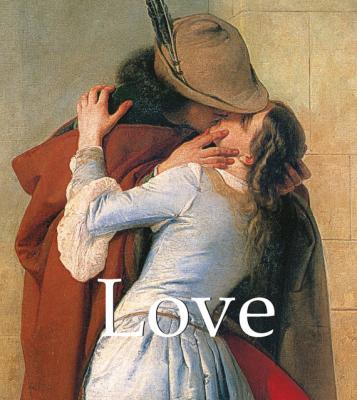Love. Jp. A. Calosse
Читать онлайн.| Название | Love |
|---|---|
| Автор произведения | Jp. A. Calosse |
| Жанр | Зарубежные стихи |
| Серия | Mega Square |
| Издательство | Зарубежные стихи |
| Год выпуска | 0 |
| isbn | 978-1-78160-978-1, 978-1-78042-229-9 |
“There is nothing more common than to speak about love; there is nothing more rare than to speak well about it.”
© Confidential Concepts, worldwide, USA
© Parkstone Press International, New York, USA
© Maurice Denis, Artists Rights Society, New York
© Tamara de Lempicka, Artists Rights Society, New York
© Pablo Picasso, Artists Rights Society, New York
Foreword
Sandro Botticelli, The Birth of Venus, 1484–1485.
Tempera on canvas, 172.5 × 278.5 cm.
Galleria degli Uffizi, Florence.
The representations of Love in Western art are unnumerable: loving emotion, agonies of the soul, melancholy… Love is an inexhaustible subject, handled in an original way according to the perception and lives of the artists and the writers of any time.
This work chooses to give a major place to the emotion, to praise the loving happiness. By representing the theme through a hundred and twenty pieces extending from the Middle Ages to the end of the Modern period, it proves the timelessness of love.
We invite you to admire the legendary sculptures such as the Gian Lorenzo Bernini’s Apollo and Daphne, Antonio Canova’s Psyche Revived by Cupid’s Kiss or Auguste Rodin’s The Kiss.
Among other mythical paintings, you will find Antoine Watteau’s The Pilgrimage on the Island of Cythera, Jean Honoré Fragonard’s The Swing or still Marc Chagall’s The Lovers in Blue. Every major artist who has celebrated the feeling of love is gathered here under your eyes.
Tamara de Lempicka, Adam and Eve, 1931.
Oil on panel, 116 × 73.
Private collection.
And what is more appropriate than poetry to illustrate this picturesque panorama? From Ovid to Verlaine, the biggest names of the literature knew how to make Eros speak.
In prose or in verse, their texts crossed the time by revealing one thousand and one faces of love. From Shakespeare’s Romeo and Juliet to Beaudelaire’s A Hemisphere in a Head of Hair, passing by Goethe’s To the Distant One, this book invites you thus for a discovery or for a rediscovery of the most famous passages of the Western literature.
Come! an Unseen Flute
Come! an unseen flute
Sighs in the orchards.
The most peaceful song
Is the song that shepherds sing.
The wind beneath the ilex
Ruffles the waters’ dark mirror.
The most joyous song
Is the song that birds sing.
Let no worry torment you.
Let us love! Let us always love!
The most sweet song
Is the song that lovers sing.
Adam and Eve
Titian (Tiziano Vecellio), c. 1550.
Oil on canvas, 176 × 191 cm.
Museo Nacional del Prado, Madrid.
Suzanne Valadon, 1909.
Oil on canvas, 162 × 131 cm.
Musée national d’art moderne, Centre Georges
Pompidou, Paris.
I have been astonished that men could die martyrs for their religion —
I have shudder’d at it.
I shudder no more.
I could be martyr’d for my religion
Love is my religion
And I could die for that.
I could die for you.
Adam and Eve
Albrecht Dürer, 1504.
Engraving, 25.1 × 20 cm.
The Metropolitan Museum of Art, New York.
The Gentle Heart
Within the gentle heart Love shelters him,
As birds within the green shade of the grove.
Before the gentle heart, in Nature’s scheme,
Love was not, nor the gentle heart ere Love.
For with the sun, at once,
So sprang the light immediately; nor was
Its birth before the sun’s.
And Love hath his effect in gentleness
Of very self; even as
Within the middle fire the heat’s excess.
Adam and Eve
Gustav Klimt, 1917–1918.
Oil on canvas, 173 × 60 cm.
Österreichische Galerie, Vienna.
The fire of Love comes to the gentle heart
Like as its virtue to a precious stone;
To which no star its influence can impart
Till it is made a pure thing by the sun:
For when the sun hath smit
From out its essence that which there was vile,
The star endoweth it.
And so the heart created by God’s breath
Pure, true, and clean from guile,
A woman, like a star, enamoureth.
The Hand of God
Auguste Rodin, 1896.
Marble, 94 × 82.5 × 54.9 cm.
Musée Rodin, Paris.
In gentle heart of Love for like reason is
For which the lamp’s high flame is fanned
But what is left to love, thus leaving thee?
Alas! that cruel land beyond the sea!
Why thus dividing many a faithful heart,
Never again to meet, when thus they part?
Apollo and Daphne
Gian Lorenzo Bernini, 1622–1625.
Marble, height: 243 cm.
Galleria Borghese, Rome.
I see not, when thy presence bright I leave,
How wealth, or joy, or peace can be
